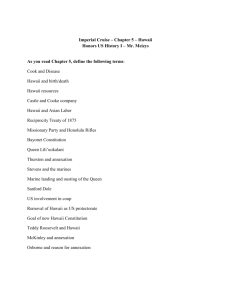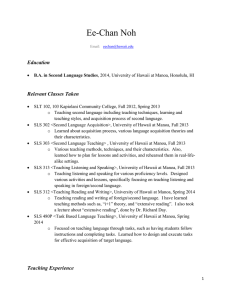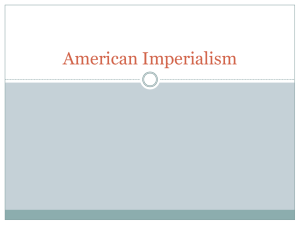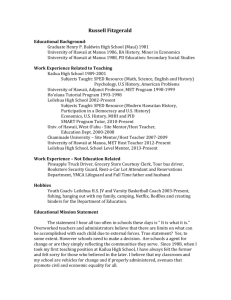Hawaii Energy Resource Technologies for Energy Security: Hawaii Energy Roadmap Terry Surles
advertisement
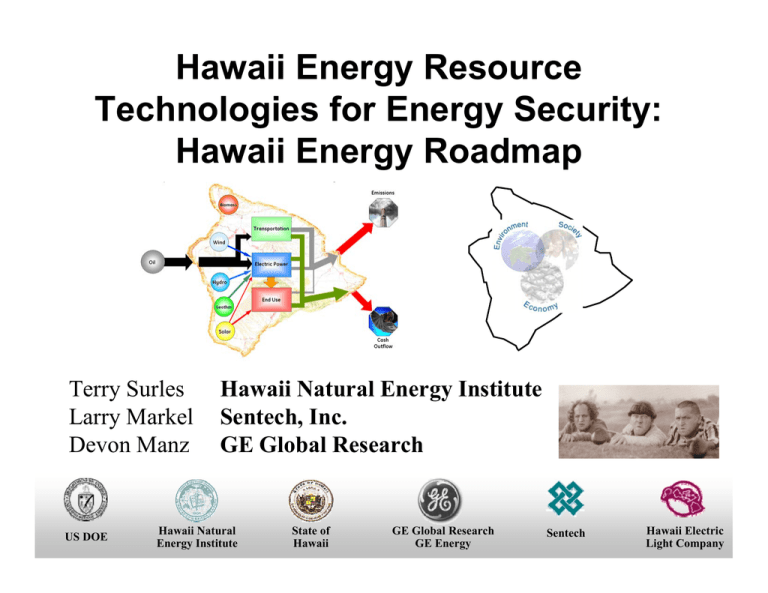
Hawaii Energy Resource Technologies for Energy Security: Hawaii Energy Roadmap Terry Surles Larry Markel Devon Manz Hawaii Natural Energy Institute Sentech, Inc. GE Global Research Hawaii Natural Energy Institute HNEI HAWAII NATURAL ENERGY INSTITUTE Hawaii Natural Energy Institute School of Ocean and Earth Science and Technology University of Hawaii at Manoa US DOE University of Hawaii at Manoa State of Hawaii GE Global Research GE Energy 1 Sentech Hawaii Electric Light Company Background: Hawaii Has Energy Concerns • 90% of the state’s energy comes from imported oil • $3B leave the economy each year to purchase fuel • Some of the highest electricity and gasoline prices in the nation • Small, sparse electricity grids pose an immediate challenge to renewables integration Hawaii Natural Energy Institute HNEI HAWAII NATURAL ENERGY INSTITUTE School of Ocean and Earth Science and Technology University of Hawaii at Manoa University of Hawaii at Manoa • New renewable generation prices tied to oil prices 2 Big Island’s Energy Challenges Transmission Congestion Hilo side = ~60% of load Kona side = ~75% of generation PPAs High cost of renewable energy (PURPA) High Energy Costs ~$100/bbl oil >35 ¢/ kWh electricity Hawaii Natural Energy Institute HNEI HAWAII NATURAL ENERGY INSTITUTE School of Ocean and Earth Science and Technology University of Hawaii at Manoa University of Hawaii at Manoa Utility Concerns Growing use of wind power is affecting grid stability & overall efficiency (spinning reserve) Wind (MW) Hz Economic Insecurity $3B/yr leaves State economy each year to purchase fuel Energy Insecurity 90% State dependence on imported petroleum 3 Challenges Have No Simple Solutions • Big Island utility not keen on wind due to system stability problems • Counter-intuitive realities – More wind = more expensive electricity – Important to know true “cost of wind” and its carbon footprint • Stakeholders initially wanted simple, straightforward solutions • GE invests in program for better understanding of marketplace • New technologies and policies have supporters and detractors – Business model uncertain for use of energy storage – Particularly true when stability is not a IPP problem – BUT, does model work if IPP is “dumping” a lot of wind Hawaii Natural Energy Institute HNEI HAWAII NATURAL ENERGY INSTITUTE School of Ocean and Earth Science and Technology University of Hawaii at Manoa University of Hawaii at Manoa 4 HNEI Catalyzes Partnerships Critical For Addressing Overarching Issues Facing Electricity Systems Electricity System Issues EnvironmentQuality Quality: Grid Modernization: Global Climate Change Energy Security: Environment Life cycle analyses Renewable Technologies Fuel Supplies, Critical Infrastructure Protection Peak Demand None Of These Issues Can Be Resolved Without Partnerships Hawaii Natural Energy Institute HNEI HAWAII NATURAL ENERGY INSTITUTE School of Ocean and Earth Science and Technology University of Hawaii at Manoa University of Hawaii at Manoa 5 Scope of Hawaii Energy Roadmap (One of Three Activities in the Hawaii-New Mexico Effort) • Develop strategic energy roadmap to identify economically viable technologies to transform Big Island energy infrastructure – Develop and validate baseline models for electricity and transportation – Rigorously link development of analytical tools to both DOE mission and utility system operations needs - no small trick (planning vs. operations) – Objective is to develop comprehensive,technology-neutral process that can be used elsewhere by DOE • Identify scenarios for deployment of new energy systems – Develop site-specific conceptual designs, i.e., incorporation of energy storage and renewable energy systems to support the electricity grid • Address systems integration (grid stability) and institutional (impacts of PPA contracts, etc.) issues Hawaii Natural Energy Institute HNEI HAWAII NATURAL ENERGY INSTITUTE School of Ocean and Earth Science and Technology University of Hawaii at Manoa University of Hawaii at Manoa 6 Program is Unique in Being Able to Address Needs of Three Different End-Users – Plus Stakeholders Meet DOE mission needs – transferability of analytical tools – An understanding of the technical impact of renewable energy deployments as they relate to the mainland – Lessons for Mainland systems and analytical tools for Mainland grids – Mechanisms for addressing stakeholder needs Address utility system planning needs – with accurate and usable tools, avoid “shelf-ware” problems – Mechanism for evaluating new technologies to address system impacts – An understanding of impacts of renewable energy technology deployments Address state (DBEDT and PUC) initiatives – A methodology and tool for State policymakers to analyze the impacts and tradeoffs of technologies (high penetration renewable energy) and policies (RPS). – An in-state capability to perform further energy analyses – starting with the PUC Provide information to commercialize clean energy products Respond to concerns of multiple business-environment-consumer stakeholders in Hawaii Big Island is a potential showcase (for DOE, Hawaii, HECO, and GE) for renewable Hawaii Natural Energy Institute HNEI energy and other innovative technologies HAWAII NATURAL ENERGY INSTITUTE School of Ocean and Earth Science and Technology University of Hawaii at Manoa University of Hawaii at Manoa 7 Electricity Infrastructure Modeling Transient Performance (GE PSLFTM) – – – Full network model, incorporating generator governors and AGC Frequency Model Historical Data 60Hz Transient Stability Simulation Long-Term Dynamic Simulation Wind Power Model Historical Data MW One hour – Sebastian Achilles – GE (Germany) Production Cost (GE MAPSTM) – – – Representation of dispatch and unit commitment rules Hour-by-hour simulation of grid operations for a full year Nick Miller Gene Hinkle, et al – GE Energy Stability & Performance Operating conditions Commitment & Dispatch MW Hawaii Natural Energy Institute HNEI 8 HAWAII NATURAL ENERGY INSTITUTE School of Ocean and Earth Science and Technology University of Hawaii at Manoa University of Hawaii at Manoa Dispatch constraints 2 weeks Production Cost Model Validation 2006 Historical Production Annual GWh MW 40 days of production MAPS Production Cost Simulation Annual GWh MW 40 days of production Hawaii Natural Energy Institute HNEI HAWAII NATURAL ENERGY INSTITUTE School of Ocean and Earth Science and Technology University of Hawaii at Manoa University of Hawaii at Manoa Less Than 1% Error By Fuel Type 9 An ability to analyze “What-if” scenarios What if 1MW of wind power were added to the island? Combined Cycle Combustion Turbine Diesel Puna Geothermal Small Hydro Steam Oil Wind Solar Grand Total GWh -2.1 -1.3 0.0 0.0 0.0 -0.6 4.1 0.0 0.1 Fuel Use MMBtu -15545 -13905 -341 0 0 -7582 0 0 -37374 Emissions (tons) CO2 NOx SOx 0 -2 -1352 -1 -2 -1245 0 0 -29 0 0 0 0 0 0 -1 -1 -726 0 0 0 0 0 0 -2 -6 -3352 HELCO Cost IPPs HELCO CC CT Diesel Steam Oil Wind …? • With no other changes to the system, an increase in wind power offsets fossil fuel generation and reduces emissions • From a cost of energy perspective, the price paid to wind producers matters • Additionally, HELCO must maintain their system frequency at 60Hz and sudden changes in wind power will affect the frequency Hawaii Natural Energy Institute HNEI HAWAII NATURAL ENERGY INSTITUTE School of Ocean and Earth Science and Technology University of Hawaii at Manoa University of Hawaii at Manoa 10 Is there more to this story? Cost Adders Wind power reduces the island’s carbon footprint, and reduces the amount of imported petroleum, but… Utility - More spinning reserve will be needed - More oil must be burned so some generation is ready to quickly meet changes in the system load or wind farm output, and/or Utility - New technologies can be used to mitigate the intermittency of wind power. ? Policymakers - Price paid to wind producers matters. If HELCO pays a wind producer more than it costs them to produce electricity from fossil fuel generation, more wind power will cost the island more (avoided oil costs) Hawaii Natural Energy Institute HNEI HAWAII NATURAL ENERGY INSTITUTE School of Ocean and Earth Science and Technology University of Hawaii at Manoa University of Hawaii at Manoa 11 Transient Performance Model Validation Significant Wind Fluctuation (04/03/07) PSLF Historical Data Frequency (Hz) Time (seconds) PSLF Historical Data Apollo Windfarm (MW) Hawaii Natural Energy Institute HNEI HAWAII NATURAL ENERGY INSTITUTE School of Ocean and Earth Science and Technology University of Hawaii at Manoa University of Hawaii at Manoa Time (seconds) 12 Stakeholder Interviews - the Start of Phase 2 • What are your key energy-related metrics? • What are your energy goals for 2020? • Is 2020 an appropriate target for the study? • What do you see as key global influences? • What do you see as key energy technologies? • What policies should Hawaii implement? • What other energy issues concern you? Stakeholder Interviews April Consolidation of Stakeholder Input May Identification of Themes July Hawaii Natural Energy Institute HNEI HAWAII NATURAL ENERGY INSTITUTE School of Ocean and Earth Science and Technology University of Hawaii at Manoa University of Hawaii at Manoa Scenario Development September County of Hawaii Energy Office Bob Arrigoni Economic Development Alliance of Hawaii Paula Helfrich Enterprise Honolulu Mike Fitzgerald and John Strom Fairmont Orchid Ed Andrews Hamakua Energy Partners Joe Clarkson Hawai‘i County Council Pete Hoffmann Hawai‘i Island Economic Development Board Mark McGuffie Hawaiian Electric Company, Ltd. Karl Stahlkopf Hawai‘i Electric Light Company, Inc. Hal Kamigaki, Chengwu Chen, Art Russell, Lisa Dangelmaier Hawi Renewable Development Jim Nestman, Raymond Kanehaikua Hilton Waikoloa Village Rudy Habelt (Director of Property Operations) Kohala Center Betsy Cleary-Cole (Deputy Director) Life of the Land Henry Curtis (Executive Director) Office of Hawaiian Affairs Mark Glick Yuko Chiba Powerlight Riley Saito State of Hawaii, Department of Business, Economic Development & Tourism John Tantlinger, Steve Alber, Priscilla Thompson State of Hawaii, Public Service Commission, Division of Consumer Advocacy Catherine Awakuni Tesoro Hawaii Corporation Carlos De Almeida University of Hawaii at Manoa 13 Makena Coffman Stakeholder Summit What we expected: Hawaii Natural Energy Institute HNEI HAWAII NATURAL ENERGY INSTITUTE School of Ocean and Earth Science and Technology University of Hawaii at Manoa University of Hawaii at Manoa What we got: 14 Scenarios Selected by Stakeholders • Addresses metrics of interest to all groups HIGHER WIND PENETRATION Given the trends in Hawaii for increased wind farm development, a renewable energy strategy consisting primarily of increased wind utilization will be considered. ENHANCED ENERGY MANAGEMENT Using new and/or innovative approaches, such as demand-side management, energy efficiency programs and plug-in hybrid electric vehicles to reshape the load profile and alter system operation. INCREASING ENERGY SECURITY Based on a specific technology deployment that is focused on using indigenous resources, especially renewable resources (wind, solar, geothermal). Hawaii Natural Energy Institute HNEI HAWAII NATURAL ENERGY INSTITUTE School of Ocean and Earth Science and Technology University of Hawaii at Manoa University of Hawaii at Manoa 15 For each Scenario we need to consider other variables… Scenario Elements Impact Energy Storage Technologies Maintains power system stability by providing support for intermittent renewables, while minimizing the curtailment of renewables. Oil Price Fluctuations in the oil price will impact the cost of electricity, transportation, citizen behavior. Carbon Policy The economics of lower carbon-emitting technologies will be enhanced relative to fossil-fuel counterparts. Renewable Portfolio Standards Alternative target dates and percentages could affect the cost of energy in a non-linear fashion. Power Purchase Agreements Changes to this policy will affect the price HELCO and ratepayers pay future independent power producers. Hawaii Natural Energy Institute HNEI HAWAII NATURAL ENERGY INSTITUTE School of Ocean and Earth Science and Technology University of Hawaii at Manoa University of Hawaii at Manoa 16 Example Scenarios: #1 - Higher Wind Penetration #2 – Enhanced Energy Management Hawaii Natural Energy Institute HNEI HAWAII NATURAL ENERGY INSTITUTE School of Ocean and Earth Science and Technology University of Hawaii at Manoa University of Hawaii at Manoa 17 Higher Wind Penetration Scenario • A substantial wind penetration was selected. • The capacity of each wind farm was increased. In 2018… In 2007… 20.6 MW 180 MW 100 30 24hr Power (MW) • Day ~ 15% • Night ~ 30% Hawi Renewables 10.5MW V47 660kW Apollo 20.5MW GE 1.5MW School of Ocean and Earth Science and Technology University of Hawaii at Manoa University of Hawaii at Manoa 220 MW 110 Lalamilo 1.5MW Jacobs 20kW 32.5MW of wind power capacity Hawaii Natural Energy Institute HNEI HAWAII NATURAL ENERGY INSTITUTE 22.1 MW 85 24hr Power (MW) 42 MW • Day ~ 40% • Night ~ 70% 84.5MW of wind power capacity 18 Higher Wind Penetration Scenario Build multiple cases in MAPS Delivered Curtailed 305 GWh 73 GWh Hawaii Natural Energy Institute HNEI HAWAII NATURAL ENERGY INSTITUTE School of Ocean and Earth Science and Technology University of Hawaii at Manoa University of Hawaii at Manoa 19 Baseline: “Business-as-usual” Scenario One hour system frequency trace • Consider the validated May 22nd historical window. • Historical load & wind production were used to drive the simulation. • An hour with low load and an intermediate wind condition was chosen in MAPS. • Units specified for this hour were used to initialize the simulation. • Similar performance Hawaii Natural Energy Institute wasHNEI observed. HAWAII NATURAL ENERGY INSTITUTE School of Ocean and Earth Science and Technology University of Hawaii at Manoa University of Hawaii at Manoa 20 Higher Wind Penetration Scenario One hour system frequency trace • Considering the same 1 hour window. • Wind power capacity was increased from ~32MW to ~85MW. • Historical load & scaled wind production were used to drive the simulation. • Units specified for this hour were used to initialize the simulation • System performance was severely affected. Hawaii Natural Energy Institute HNEI HAWAII NATURAL ENERGY INSTITUTE School of Ocean and Earth Science and Technology University of Hawaii at Manoa University of Hawaii at Manoa 21 Strategy for Improving Grid Stability Is short time-scale energy storage a viable option? • Considering the same May 23rd historical window • Expand the Apollo wind farm by 3MW, then 6MW • Short time-scale energy storage showed substantial reduction in frequency sag. Frequency comparison 60.02 60.00 60 60.00 60 59.98 59.96 Hz Hz [Hz] Hz 59.94 59.92 Apollo Apollo + 3MW Apollo + 6MW 59.9 fn o m 59.88 1600 No Storage Storage (1MW, 60s) Storage (1MW, inf.) 59.9 fNo storage No nom storage Storage fnom +real storage (60MWs) (60MW-sec) Storage (1MW, 60seconds) i(1MW, nf MWs MW-sec) ) ((inf Storage infinite) fStorage +inf storage nom fn o m+ 3 MW fn o m+ 6 MW 59.86 59.86 59.95 1650 1700 1750 1800 1850 1900 400 seconds Hawaii Natural Energy Institute HNEI HAWAII NATURAL ENERGY INSTITUTE School of Ocean and Earth Science and Technology University of Hawaii at Manoa University of Hawaii at Manoa 1950 2000 59.85 59.85 1000 1200 1400 1600 1800 2000 2200 time [s] 2400 2600 2800 3000 3200 2200 seconds Tim e (seconds) 22 Higher Wind Penetration Scenario System Frequency Performance Higher Wind Penetration Scenario • As the size of the storage device increases, the system frequency RMS decreases. • “Higher Wind Penetration” + 5MW storage device reduces system frequency RMS to below that of the “Business-as-usual” case • 3-5 minutes of energy storage was needed for the simulation. Hawaii Natural Energy Institute HNEI 23 HAWAII NATURAL ENERGY INSTITUTE School of Ocean and Earth Science and Technology University of Hawaii at Manoa University of Hawaii at Manoa Enhanced Energy Management •7MW uniform load reduction due to energy efficiency +10MW reduction by load factor due to energy efficiency +10% PHEV penetration (nighttime charging) +7MW peak reduction shifted to nighttime due to thermal storage +5MW peak shifted to nighttime due to residential load control Hawaii Natural Energy Institute HNEI HAWAII NATURAL ENERGY INSTITUTE School of Ocean and Earth Science and Technology University of Hawaii at Manoa University of Hawaii at Manoa 24 Effort Allows DOE to Address National Problems While Solving Local Issues • Effect of non-dispatchable, intermittent renewables on the grid - Big Island is experiencing it first (200MW grid vs. 55GW system in CA) • Future interconnections of transportation and electricity systems must be evaluated, i.e., PHEV • Congestion issues - load centers versus generation, particularly for remote renewable resources and load centers on Mainland • Developed effective mechanisms for addressing stakeholder concerns • Informed regulatory leaders on cost and systems issues associated with greater penetration of renewables on grid – Incentivize the utility to promote renewables – Encourage utility to partner with customers and IPPs for DG, CHP, energy efficiency – important to Stakeholders – Evaluate power purchase agreement terms (PPA) Hawaii Natural Energy Institute HNEI HAWAII NATURAL ENERGY INSTITUTE School of Ocean and Earth Science and Technology University of Hawaii at Manoa University of Hawaii at Manoa 25 These Systems Also Allow DOE the Opportunity to Examine • O&M stresses as a result of ancillary services – reduced heat rate and other sub-optimal operating conditions for spinning reserve • New storage, power electronics, and information systems to improve system reliability and stability with relatively large penetrations of intermittent renewable energy • Nature of current IPP contract agreements – Just buying watts, no consideration for reactive power, grid stability, use of storage systems – Tied to avoided costs for oil, doesn’t address spinning reserve – Use of oil goes down and electricity prices go up These lessons learned are immediately applicable Hawaii Natural Energy Institute HNEI to Mainland systems. HAWAII NATURAL ENERGY INSTITUTE School of Ocean and Earth Science and Technology University of Hawaii at Manoa University of Hawaii at Manoa 26 Use of These Tools Will Also Evaluate State RPS Goals as Funded by the Hawaii PUC Maui Grid Study – Utility and DOE Phase 1 – Model & validate the power system Phase 2 – Evaluate scenarios in order to understand: • • Oahu Wind Study - Utility The economic & performance impacts of more wind The mitigating technologies (e.g. storage, controls) required to increase wind capacity. Big Island Energy Roadmap – DOE and Utility To evaluate key, wind projects that would impact the Island, including the Phase 2 - Evaluate scenarios to identify the performance of various technology Lanai (300MW) / Molokai approaches. (200MW) wind projects with Proposed Phase 3 – Demonstration underwater HVDC to Oahu project – “Iron on the ground” (discussions underway) Hawaii Natural Energy Institute HNEI HAWAII NATURAL ENERGY INSTITUTE School of Ocean and Earth Science and Technology University of Hawaii at Manoa University of Hawaii at Manoa 27 An ongoing public/private partnership Our unique team (DOE, HNEI, GE, Sentech, HECO, DBEDT) offers an unprecedented opportunity for linking R&D and public policy to the commercialization process Basic Research & Development National Laboratories Collaborative Technology Development Integration Application Industry R&D Technology Commercialization Suppliers Vendors Universities Institutional Issues Regulations Incentives End Users Government Hawaii Natural Energy Institute HNEI HAWAII NATURAL ENERGY INSTITUTE School of Ocean and Earth Science and Technology University of Hawaii at Manoa University of Hawaii at Manoa 28


